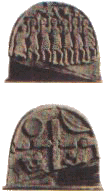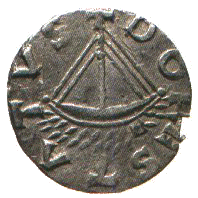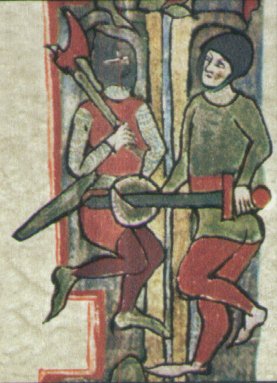

|
| |
 |
the history of Wieringen
|
 | Lindisfarne, Northumbria"793, in that year people in Northumbria saw terrible signs, that frightened them very much... heathens destroying God's church at Lindisfarne..."Many century people still talk with awe about the disasters that came on the English coasts, and monuments are erected in remembrance. |
The knowledge we have in Western Europe about the Vikings or Norsemen is largely from Carolingian monastery chronicals. Since the rich monasteries were a favourite target for the Norsemen, it is not strange to find the image of them rather distorted, to put it mildly.
On the one hand we have them depicted as robbing, pillaging, raping and murdering heathen barbarians and on the other hand the fearless navigators and discoverers who traded with the Russians and Arabs, colonised Iceland and Greenland and even discovered Northern America centuries before Columbus. Somewhere between the two we find the Frisian traders who had no problems supplying the Scandinavians with Frankish swords before they became restless and became the Vikings. Some decades later Dorestad, the most important Frisian tradecity was destroyed thanks to the Frankish swords.
 The Vikings were very interested in the silver of Dorestad. Money from Dorestad was held in high regard among the Vikings. So much even, that when Dorestad was destroyed, local mint-masters in Hedeby and other Scandinavian cities tried to copy the Dorestad coins. |  |
Whatever opinion one has of the Vikings, it's a fact that certain developments in Scandinavia (a growing population and a culture that was centered on acquiring status through wealth) led to the equipment of ships in order to gather wealth in faraway places. Whether this happened through trade or theft was of lesser importance for the Vikings. .
 <-- Fragment from Snorri Sturluson's manuscript
<-- Fragment from Snorri Sturluson's manuscript A longer story tells about a journey to Friesland as well. A mansionkeeper called Arinbjörn was at his farm, but in the spring he wanted to go on an adventure. He arranged three Vikingships and a crew of 300, his own personnel, but also people from neighbouring farms. When he was about to leave, Egil from Iceland arrived with his tradeship. He let his ship continue to the Oslo-Fiord and decided to join Arinbjörn on his adventure.
A longer story tells about a journey to Friesland as well. A mansionkeeper called Arinbjörn was at his farm, but in the spring he wanted to go on an adventure. He arranged three Vikingships and a crew of 300, his own personnel, but also people from neighbouring farms. When he was about to leave, Egil from Iceland arrived with his tradeship. He let his ship continue to the Oslo-Fiord and decided to join Arinbjörn on his adventure.
After a few days they reached Friesland, and at night they sailed a large river. The fields on both shores were wet and soggy, but still they landed. One third of the men stayed behind to watch the ships. The Frisian farmers fled, but assembled at one point from where they attacked the Vikings with three hundred men. The Vikings were much stronger and won the battle. The Frisians ran away. As it happened they had dug ditches around their fields and meadows to improve the drainage. At one of the larger ditches they managed to quickly dismantle the bridge, thus stopping the Vikings. Egil was the only one that didn't stop. He jumped over, a thing no other Viking could imitate, and singlehandedly killed all Frisians that stood there.
His companions hadn't expected that he would survive his little adventure and had left, meanwhile gathering a lot of loot. When Egil was finished, he restored the bridge and returned to his ship. However, other Frisians had regrouped between him and his ship and they cut him off. Egil, being a true Viking hero, was not impressed. He threw his shield on his back, held his spear before him and stormed toward his ship. Everyone jumped away in fright. So he appeared, as returned from Walhalla, before his men.
It is tempting to look for parallels in the story of Egil, and to even find them for Wieringen. Wieringen lay on the borders of a large river, the Vlie, in the middle of Friesland. The ditches to drain the surplus water must have been common in the lower lands around Wieringen. At least ditches were unknown in Scandinavia, so that we can not simply dismiss this story as a legend.